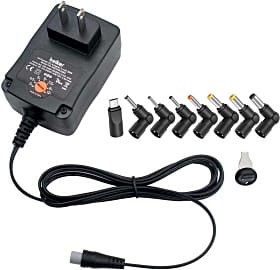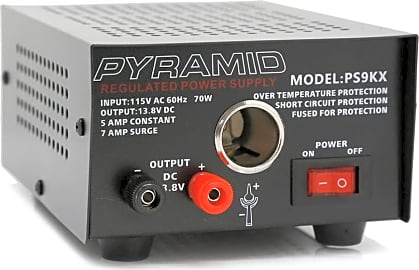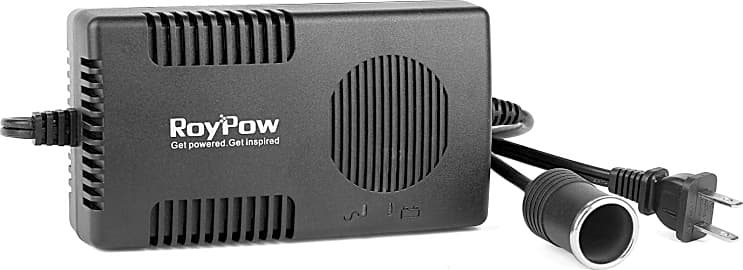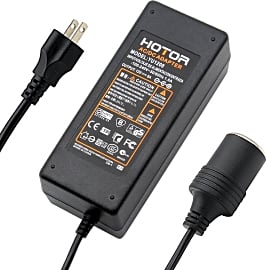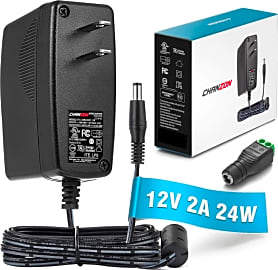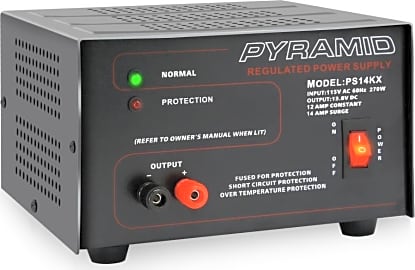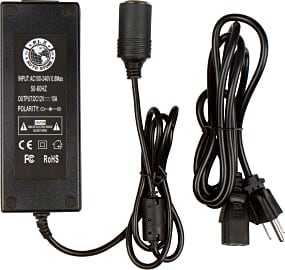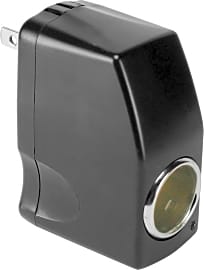The 10 Best AC To 12V Adapters

This wiki has been updated 35 times since it was first published in May of 2016. A lot of devices are powered by 12-volt DC electricity so they can be used while traveling. Typically, these products can only be operated in vehicles, because buildings are wired with alternating current. So if you've got a handy portable vacuum cleaner, mini fridge, shaver, or car seat massage cushion and want to use it indoors, you'll need one of these AC to DC adapters. When users buy our independently chosen editorial selections, we may earn commissions to help fund the Wiki.
Editor's Notes
May 07, 2021:
We haven't added or removed anything during this update, and we just want to briefly touch on the general differences between the types. Models like the Hotor Converter and RoyPow C180B are meant for devices that utilize the standard cigar-lighter plug, which allows you to use a wide range of products indoors that were designed for use in cars. Meanwhile, the Chanzon Wall Wart is a replacement for the most common size of barrel plug, and the Belker UA-30 lets you choose exactly the format you need. Finally, benchtop options like the Pyramid PS9KX and Pyramid PS-14KX are aimed primarily at hobbyists.
March 27, 2020:
There are a few different types of AC to 12-volt DC adapters out there, and they're all meant for different purposes. Models like the RoyPow C120 and RoyPow C180B, which put out up to 15 and 10 amps, respectively, are designed to power portable automotive electronics using a 110-volt outlet. The P.I. Auto Store Premium is similar but gets noticeably hotter than the RoyPows, and the Hotor Converter is a bit less expensive but doesn't have the same capacity. These are especially good for charging and using car vacuums and portable DVD players when all you have on hand are their 12-volt adapters. The Cellet FM1500 is a little bit similar to them, except it's built more like a common wall wart and limited to a maximum current of 2 amps.
Speaking of wall warts, the Chanzon Wall Wart is a good one, although its 5.5mm by 2.5mm barrel plug is fixed, so if you need a different plug type, look to the Belker UA-30, which comes with a bevy of removable barrel plugs and even a micro USB adapter.
The most advanced models on our list are switched-mode benchtop power supplies from a high-end manufacturer called Pyramid. The Pyramid PS9KX, Pyramid PSV150, and Pyramid PS-14KX are, in a sense, good, better, and the best options for powering advanced electronics like ham and CB radios, as their advanced circuitry ensures that these more sophisticated devices will run safely. They include features like regulators, fuses, and on-off switches that most automotive appliances don't generally need.
High Voltage: A History Of Electricity
For the overwhelming majority of our species' history, electricity was a poorly understood, nearly magical occurrence that acted exclusively of its own accord.
For the overwhelming majority of our species' history, electricity was a poorly understood, nearly magical occurrence that acted exclusively of its own accord. The first known observations of the phenomenon were Egyptian accounts of electric eels, described as the protectors of all fish due to their shocking ability to defend themselves. Numerous natural philosophers would muse on this flashy mystery over the next few thousand years, yet none would accurately describe the nature of electricity or be able to harness it for quite some time. For that matter, there's a small group of outliers who believe that an artifact unearthed in the Middle East in the 1930s is a primitive electro-plating device, which would indicate that cultures knew how to manipulate electricity thousands of years ago. However, no electro-plated objects have ever been found associated with such an ancient era. Furthermore, the artifact in question, the Baghdad Battery, was more than likely just a scroll case. There is, however, linguistic evidence that around 500 years ago, some Arabic-speaking peoples finally associated those painfully memorable eels with lightning, the cause of which had so far confounded observers.
A slow and steady stream of study and publications began around 1600 C.E., spanning over two centuries, including the year 1752 when Ben Franklin conducted his famous kite experiment. A few generations later, in the late 1800s, things would really get cooking. Most people are somewhat aware that Thomas Edison refined the light bulb and helped usher in the age of electricity. Increasing numbers of people know about one of his most renowned cohorts, Nikola Tesla. These two prominent and friendly scientists were embroiled for many years in what's now known as the War of the Currents. Despite what some popular sources claim, the two displayed little to no animosity towards each other, in fact at times even assisting with or praising the other's work (nor did Edison publicly torture animals in order to prove the dangers of AC). Tesla was charismatic, creative, and a true marketing genius, but made several remarkably poor business decisions. As such, he convinced the world to adopt alternating current, but missed out on countless riches due to poor professional practices. Edison's side also won, in a way, because once we get the AC energy where we need it to go, we very often convert it to DC before use.
Over the next 100 years, the study of electricity advanced at a blistering pace, and engineers continued to manipulate it to more and more complex ends. At the beginning of a new age, 1947 saw the birth of the transistor, and over the next several decades, this groundbreaking electrical switch would shrink down to nanoscopic size. Today, electrical signals are modus operandi for countless microchips and memory banks embedded in a multitude of items, forming a backbone of society, while also satisfying our entertainment needs.
What's The Difference?
First of all, electricity is simply the flow of charged particles, and in the cases of AC and DC, those particles are electrons. The fundamental difference between the two is their direction of travel; alternating current switches back and forth at a certain rate, referred to in Hertz. This causes the flow to take the form of a sine, square, or triangle wave, and its constantly reversing nature allows it to travel extremely long distances at high power without dissipating much energy. Direct current, on the other hand, travels in a single direction, and though it's extremely inefficient over long distances, its ability to provide a constant current at comparitively low energy levels makes it the ideal choice for powering the smaller, more sensitive devices that now fill our world.
It's not too difficult to tell which devices use each type of power. Simple (and often larger) electrical appliances like refrigerators, toasters, and light bulbs simply need to tap into AC to run. Electronic devices, characterized by more advanced hardware such as transistors, vacuum tubes, and integrated circuits, require a consistent voltage in order to operate at all. Luckily, the plug formats for the two opposing currents are entirely incompatible; supplying the wrong type of current will more than likely cause a device to explode, and electrical fires really are quite the bummer.
More Than Just A Cigar Lighter
Back when smoking had much more of a social presence, people did use that push-button plug to burn dank, rolled tobacco. Nowadays, most new cars don't actually include the heating element portion, but the connector itself remains, due almost entirely to convenience. The truth is, it's not the most effective connector, as it's rather bulky and has a relatively low load rating. But after decades of manufacturers designing products for in-car use, the 12-volt plug is here to stay.
Additionally, should you misplace a object's proprietary DC cord, the standardized barrel plugs and output levels allow you to safely replace it with an aftermarket model.
Additionally, many devices operate using what's called a coaxial power connector, or more commonly a barrel plug, whose wiring most often originates at a small transformer box plugged into a wall outlet. This small, versatile plug culminates in a cylindrical, metal connector, with a simple sleeve and core accommodating the positive and negative terminals, forming a complete circuit.
Similar to the power company's transformers, these wall warts break down high-voltage AC energy into a smaller and more usable current. Unlike those large distribution boxes, however, these convert those waveforms into the direct current that most portable devices use. Items like electric coolers, auto vacuums, and tire pumps can sometimes come in handy in indoor situations. Additionally, should you misplace a object's proprietary DC cord, the standardized barrel plugs and output levels allow you to safely replace it with an aftermarket model.
It doesn't hurt to do a little math before purchasing an adapter. Remember that volts, multiplied by amps, equals watts, and compare that to your device's nominal draw to make sure it's a safe match. Adapters like these can get very hot with extended use, especially if they're overloaded. So, be certain that the adapter you choose can support the intended power levels, because no one likes melted plastic and flying sparks.


